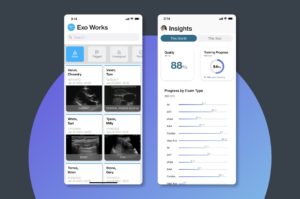
Clinicians collaborate to advance imaging at the bedside
When a patient comes to the emergency department with chest pain, shortness of breath or trauma, physicians have a variety of tools at their disposal to make a diagnosis. This includes portable ultrasound technology that can be used at an individual’s bedside to get a look inside the body.
While valuable, physicians often don’t record using the tool in an emergency situation. That’s because they don’t want to get distracted from addressing their patient’s needs. As a result, hospitals can’t bill insurance for employing ultrasound technology to save someone’s life.
“Over a year, data showed that 724 beside ultrasounds were performed at OSF HealthCare Saint Francis Medical Center,” said Nick Cohen, a project manager with Integrated Solutions Deployment for OSF. “However, only four of those were moved to a final status.”
That’s why OSF HealthCare jumped at the chance to work with OSF Ventures portfolio company, Exo®, on mobile software to streamline the point-of-care ultrasound process. With help from OSF IT, emergency department physicians at OSF Saint Francis Medical Center and OSF Innovation, the company recently unveiled Exo Works™ to the world.
Streamlining the ultrasound workflow process
Exo initially worked with OSF IT to design the infrastructure of the software using the simulation space at the Jump Trading Simulation & Education Center. From there, the company met with ED physicians from OSF Saint Francis to understand the challenges of “at the bedside” ultrasound workflow first-hand, from scanning to patient entry, to documentation and review, to archive and billing.
What they learned is that these physicians rarely had time to properly order, document, approve and store images in an emergency situation.
“This isn’t something doctors want to worry about while they are trying to save someone’s life,” said John Wipfler, MD, an attending emergency physician at OSF HealthCare Saint Francis Medical Center. “We want to use the tool to diagnose and treat someone as soon as possible. We can’t wait for an order to go through.”
Once a diagnosis and treatment is made with the current process, ED physicians have to go back to the ultrasound system, find their patient and enter an order for an ultrasound into the individual’s electronic medical record (EMR). They then have to review images for quality assurance, approve and send them off to billing. All of this typically happens at the end of a physician’s shift.

In addition, attending physicians also have to review and approve any ultrasound images medical students and residents take during their shifts and track their hours for credentialing purposes.
“We might get up to eight residents sending us images to review and approve in a given day,” said Dr. Wipfler. “But we sometimes can’t get to these until days after the images are taken. At that point, it’s too late to submit the ultrasound pictures to insurance.”
With expertise from OSF IT, OSF Innovation and ED physicians as well as key opinion leaders at other institutions, Exo created a point-of-care ultrasound workflow solution that streamlines image review, documentation, quality assurance, billing and credentialing all into one platform. The software can be used with virtually any ultrasound device, picture archiving and communication system (PACS) and EMR, and works on mobile devices and desktops.
“Once an ED physician is done with their day, they typically have to stay at the hospital to review images and submit them for billing,” said Dr. Wipfler. “With this new software, we can use our phones to bring these images up at home for approval.”
Overall, Dr. Wipfler is proud of the work he and his fellow colleagues were able to do on the Exo Works project.
“It was neat to work with smart and dedicated people on a solution I believe will remove barriers for physicians using ultrasound in the ED,” said Dr. Wipfler. “This was also an opportunity for me to contribute to a product that will help improve outcomes for our patients.”
What’s next?
With help from Performance Improvement, ED physicians at OSF Saint Francis will test the finished product before deciding whether to move forward with a full pilot. At the same time, Exo will also bring its flagship handheld ultrasound technology to OSF for physicians to provide feedback on.
The pocket-sized tool, which is still under development, is what originally sparked OSF Ventures to invest in the company.
“Through research and talking to our own physicians, we learned that handheld medical imaging devices like Exo’s have the chance to become the new digital stethoscope of the 21st century,” said Mayank Taneja, director of Venture Investments for OSF Ventures. “They offer sharp images on a mobile device at any point of care, but at a much more affordable price than current technology.”
This collaborative effort is an example of how OSF continues to build a culture of innovation that is only possible with dedicated clinical leaders and engagement to support piloting new solutions.